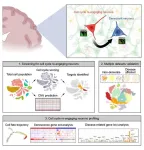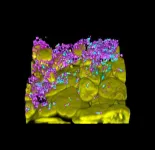(Press-News.org) In a new study in Issues, Dominique J. Baker, an associate professor in the College of Education and Human Development and the Joseph R. Biden, Jr. School of Public Policy & Administration at the University of Delaware, explored the role of student loans on hopeful students striving for college degrees, particularly in STEM.
The cost of attending a public four-year college in the United States has more than doubled since the early 1990s, when inflation is factored in.
Undergraduate student loan debt has become unmanageable for a wide swath of borrowers in the United States. Bachelor’s degree recipients borrow on average $41,300, with a median of $30,000. The median borrower still owes 92% of their loan four years after earning a bachelor’s degree, and nearly one-third of people who took out a student loan between 1998 and 2018 fell into default. As part of its emergency response to the pandemic, the US Department of Education suspended action on federal student loans that were in default as of March 13, 2020, until at least September 2024.
Student loan debt is uneven across racial groups.
Recent data has also shown variation in loan repayment patterns by major, challenging the popular assumption that all STEM graduates have similar prospects after college. Though the median amount owed on student loans for STEM majors four years after earning their degree is 80%, this varies—from 59% for engineering to 94% for biological and physical sciences and agricultural sciences. These figures do not include the amount of additional debt students may incur in pursuit of further graduate education. Due to interest accrual, delayed repayment of undergraduate student loans can also result in greater debt burdens.
The fact that differential tuition may make a STEM major more expensive than a non-STEM major at some universities deserves more attention when considering how to make STEM degrees more affordable. For example, advanced, in-state students at the University of Maryland pursuing engineering and computer science degrees pay $1,500 more per semester than their peers enrolled in other disciplines (nearly 27% higher).
The United States currently relies on a rough patchwork of policies and mechanisms to project the image of college affordability while actually depending on students to navigate huge variances in higher education costs. Inevitably, they’re often left to shoulder a debt burden that might follow them around for decades. Lessons from other countries on how to assemble the policy patchwork more deliberately—to actually lower student costs and subsidize tuition in targeted disciplines—may help.
Experts on college affordability, tuition setting, and other related topics in higher education should convene to examine the value of tuition caps as a policy, particularly within the context of bringing the missing millions into STEM disciplines. Since most public university subsidies come from state coffers, federal efforts alone are unlikely to solve college affordability. And yet there are no clear policy tools available to ensure that states contribute their due for higher education. The decentralized nature of US higher education conceals useful information from researchers, decisionmakers, and policymakers—like the national average tuition increase for STEM degrees under differential tuition. Higher education leaders, especially in STEM fields, should be invested in creating spaces for ongoing conversations about real changes in college affordability as another avenue for removing barriers to STEM education and careers.
END
Research reveals tools to make STEM degrees more affordable
The cost of attending a public four-year college in the United States has more than doubled since the early 1990s.
2024-04-23
ELSE PRESS RELEASES FROM THIS DATE:
Q&A: UW research shows neural connection between learning a second language and learning to code
2024-04-23
As computer programming becomes an increasingly valued skill in the workforce, there is a greater need to understand how people learn to code most effectively.
Statistics show that up to 50% of students who enroll in introductory programming courses in the United States eventually drop out, suggesting a mismatch between how coding is learned and the way it’s taught. A new study from the University of Washington, published March 5 in Scientific Reports, examines that issue.
The researchers recorded electrophysiological brain responses of varyingly skilled programmers as they read ...
Keane wins 2024 Gopal K. Shenoy Excellence in Beamline Science Award
2024-04-23
Physicist Denis T. Keane is the 2024 recipient of the Gopal K. Shenoy Excellence in Beamline Science Award. He is a beamline scientist and director of the Dupont-Northwestern-Dow Collaborative Access Team (DND-CAT) at the U.S. Department of Energy’s (DOE) Advanced Photon Source (APS) at DOE’s Argonne National Laboratory. He is also a research professor in the Materials Science and Engineering Department at Northwestern University.
The annual award recognizes active beamline scientists at the APS, ...
Livestock abortion surveillance could protect livelihoods and detect emerging global pathogens
2024-04-23
A small-scale surveillance system in Tanzania for reporting livestock abortions could help protect livelihoods and provide insights on potential livestock-to-human infections.
The research, published April 16 as a Reviewed Preprint in eLife, is described by editors as an important study with convincing findings of potential interest to the fields of veterinary medicine, public health and epidemiology.
Loss of livestock through abortion is a major concern for the worldwide livestock industry, resulting in significant ...
Optimal timing maximises Paxlovid benefits for treating COVID-19
2024-04-23
Researchers have described the optimal timing for COVID-19 patients to take the antiviral, Paxlovid, to get the most benefit from the treatment, according to a study published April 16 in eLife.
The findings suggest that taking Paxlovid three to five days after COVID-19 symptoms emerge may maximise the drug’s ability to reduce viral loads, minimise viral spread and reduce viral rebound. They also indicate that broader use of Paxlovid during this window might be a powerful tool to help curb the spread of the SARS-CoV-2 ...
IU researchers receive $4.8 million grant to study the role of misfolded protein TDP-43 in neurodegenerative diseases
2024-04-23
INDIANAPOLIS—A new $4.8 million grant will support researchers from Indiana University School of Medicine and the Medical Research Council Laboratory of Molecular Biology to study how human neurodegenerative diseases are affected by the misfolding of the protein TDP-43. Misfolding occurs when a protein adopts a conformation which differs from the native one.
The researchers, funded by the National Institute of Neurological Disorders and Stroke, have developed an innovative approach to deciphering the role of TDP-43 misfolding in the pathology ...
DOE’s Office of Science Graduate Student Research Program selects 86 outstanding US graduate students
2024-04-23
WASHINGTON, D.C. – The Department of Energy’s (DOE’s) Office of Science has selected 86 graduate students representing 31 states and Puerto Rico for the Office of Science Graduate Student Research (SCGSR) program’s 2023 Solicitation 2 cycle. Through world-class training and access to state-of-the-art facilities and resources at DOE national laboratories, SCGSR prepares graduate students to enter jobs of critical importance to the DOE mission and secures our national position at the forefront of discovery and innovation.
“The Graduate Student Research program is a unique opportunity ...
This tiny chip can safeguard user data while enabling efficient computing on a smartphone
2024-04-23
Health-monitoring apps can help people manage chronic diseases or stay on track with fitness goals, using nothing more than a smartphone. However, these apps can be slow and energy-inefficient because the vast machine-learning models that power them must be shuttled between a smartphone and a central memory server.
Engineers often speed things up using hardware that reduces the need to move so much data back and forth. While these machine-learning accelerators can streamline computation, they are susceptible to attackers who can steal secret ...
World’s chocolate supply threatened by devastating virus
2024-04-23
A rapidly spreading virus threatens the health of the cacao tree and the dried seeds from which chocolate is made, jeopardizing the global supply of the world’s most popular treat.
About 50% of the world’s chocolate originates from cacao trees in the West Africa countries of Ivory Coast and Ghana. The damaging virus is attacking cacao trees in Ghana, resulting in harvest losses of between 15 and 50%. Spread by small insects called mealybugs that eat the leaves, buds and flowers of trees, the cacao swollen shoot virus disease (CSSVD) is among the most damaging threats to the root ingredient of chocolate.
“This ...
Wake up and die: Human brain neurons re-entering the cell cycle age quickly shift to senescence
2024-04-23
Post-mitotic neurons in the brain that re-enter the cell cycle quickly succumb to senescence, and this re-entry is more common in Alzheimer’s disease, according to a new study published April 9th in the open-access journal PLOS Biology by Kim Hai-Man Chow and colleagues at the Chinese University of Hong Kong. The phenomenon may provide an opportunity to learn more about the neurodegeneration process, and the technique used to make this discovery is readily applicable to other inquiries about unique populations of cells in the brain.
Most neurons in the ...
Phage therapy is being explored to treat multidrug-resistant bacterial infections, but what are the direct effects of phages on the human host?
2024-04-23
Phage therapy is being explored to treat multidrug-resistant bacterial infections, but what are the direct effects of phages on the human host?
This study shows that therapeutic phages can be detected by epithelial cells of the human respiratory tract, eliciting proinflammatory responses that depend on specific phage properties and the airway microenvironment.
#####
In your coverage, please use this URL to provide access to the freely available paper in PLOS Biology: http://journals.plos.org/plosbiology/article?id=10.1371/journal.pbio.3002566
Article ...
LAST 30 PRESS RELEASES:
Scientists use ultrasound to soften and treat cancer tumors without damaging healthy tissue
Community swimming program for Black youth boosts skills, sense of belonging, study finds
Specific depressive symptoms in midlife linked to increased dementia risk
An ‘illuminating’ design sheds light on cholesterol
Who is more likely to get long COVID?
Study showcases resilience and rapid growth of “living rocks”
Naval Research Lab diver earns Office of Naval Research 2025 Sailor of the Year
New Mayo-led study establishes practical definition for rapidly progressive dementia
Fossil fuel industry’s “climate false solutions” reinforce its power and aggravate environmental injustice
Researchers reveal bias in a widely used measure of algorithm performance
Alcohol causes cancer. A study from IOCB Prague confirms damage to DNA and shows how cells defend against it
Hidden viruses in wastewater treatment may shape public health risks, study finds
Unlock the power of nature: how biomass can transform climate mitigation
Biochar reshapes hidden soil microbes that capture carbon dioxide in farmland
Reducing saturated fat intake shows mortality benefit, but only in high-risk individuals
Manta rays create mobile ecosystems, study finds
Study: Mixed results in using lipoic acid to treat progressive multiple sclerosis
Norbert Holtkamp appointed director of Fermi National Accelerator Laboratory
New agentic AI platform accelerates advanced optics design
Biologists discover neurons use physical signals — not electricity — to stabilize communication
Researchers discover that a hormone can access the brain by hitchhiking
University of Oklahoma researcher awarded funding to pursue AI-powered material design
Exploring how the visual system recovers following injury
Support for parents with infants at pediatric check-ups leads to better reading and math skills in elementary school
Kids’ behavioral health is a growing share of family health costs
Day & night: Cancer disrupts the brain’s natural rhythm
COVID-19 vaccination significantly reduces risk to pregnant women and baby
The role of vaccination in maternal and perinatal outcomes associated with COVID-19 in pregnancy
Mayo Clinic smartwatch system helps parents shorten and defuse children's severe tantrums early
Behavioral health spending spikes to 40% of all children’s health expenditures, nearly doubling in a decade
[Press-News.org] Research reveals tools to make STEM degrees more affordableThe cost of attending a public four-year college in the United States has more than doubled since the early 1990s.


